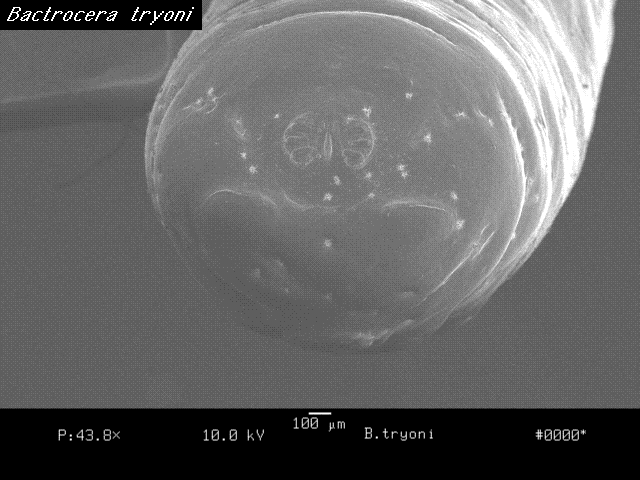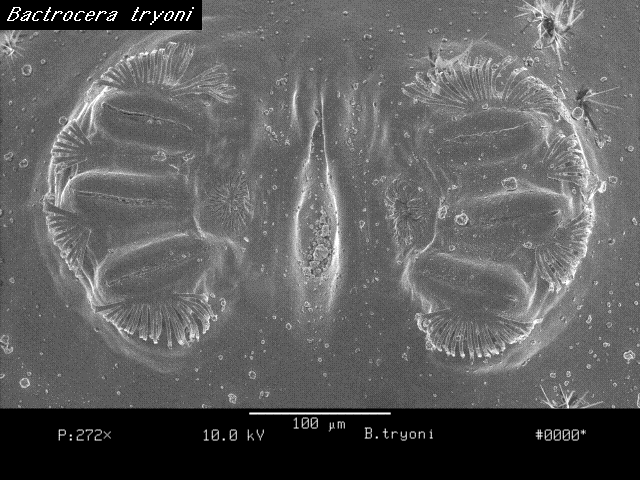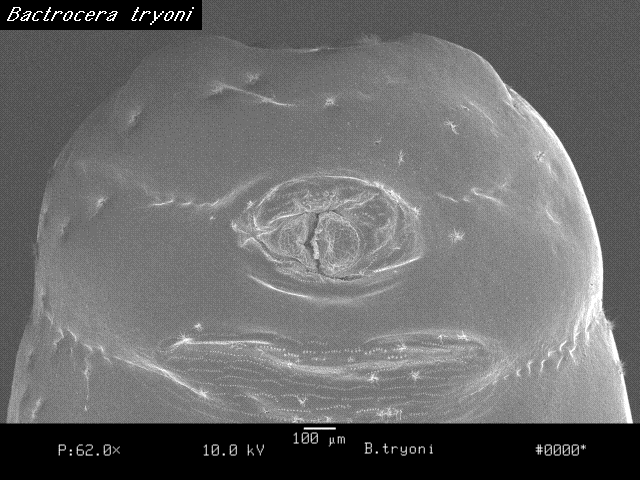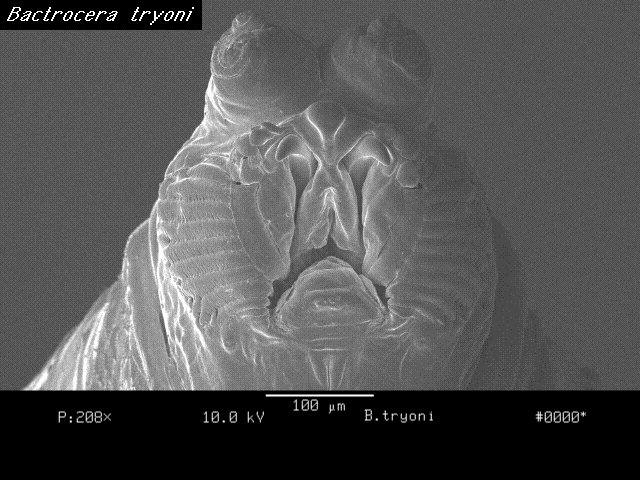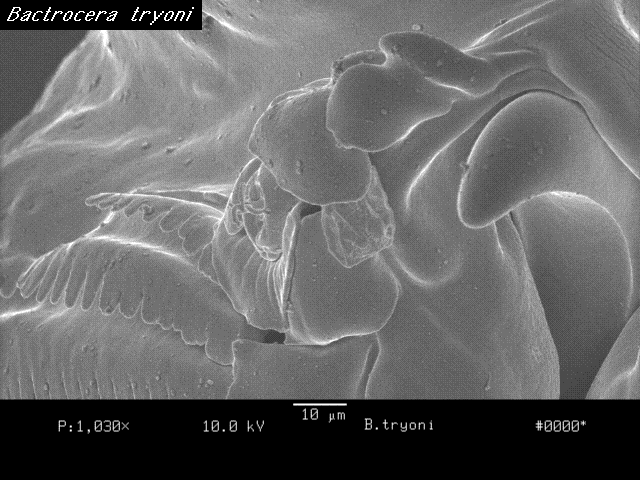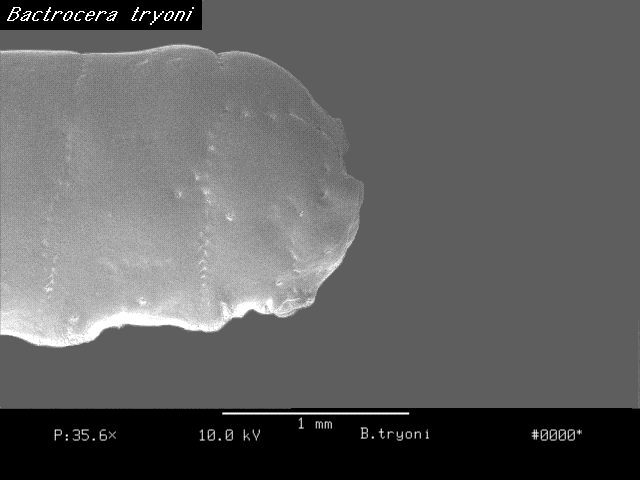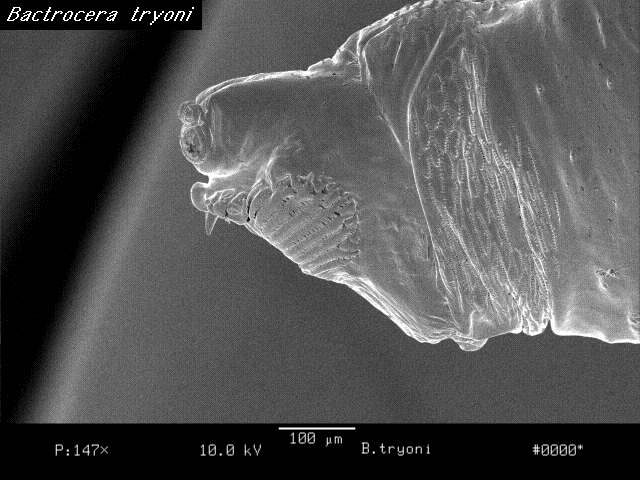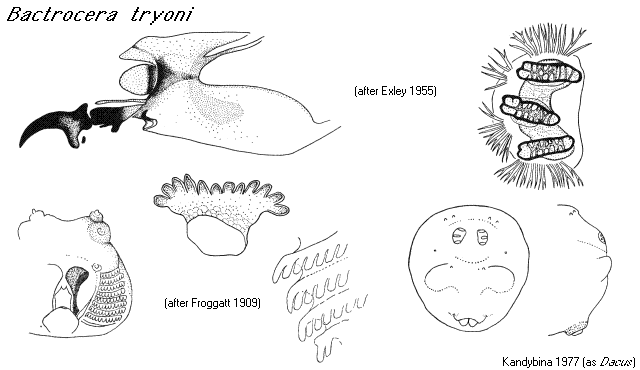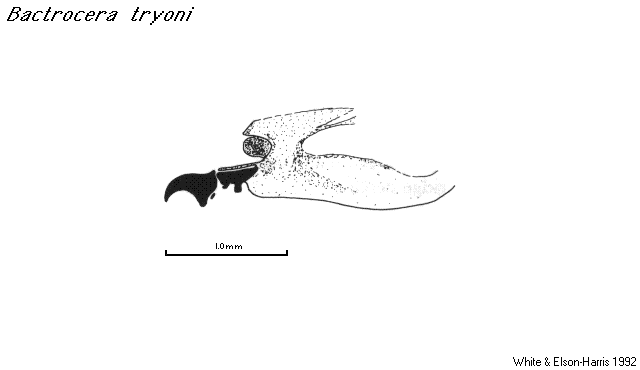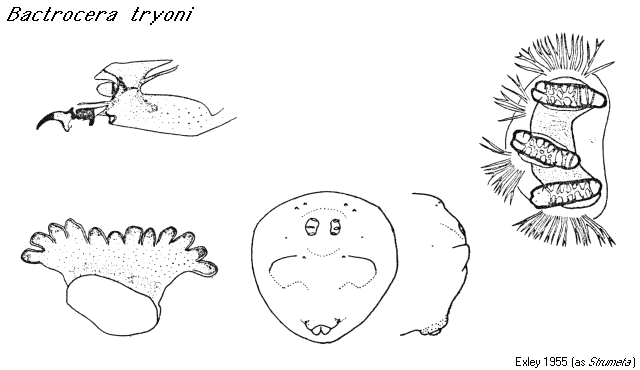Bactrocera tryoni
Common name
Queensland fruit flyDescription
Typical of Bactrocera larvae with the following specific characteristics for the third instar:
Body. Body length 8–11mm.
Head. Stomal organ: number of peg sensilla three; peg sensilla with many long branches; other peg-sensilla-like structures absent. Stomal region: secondary lobes short, leaf-like (6, large); margins of secondary lobes all entire. Number of oral ridges 9–12; margins scalloped (deeply serrated, bluntly rounded teeth; fringelike). Accessory plates small; number of accessory plates 8–12; margins serrated. Median oral lobe absent or not protruding.
Spinules and creeping welts. Dorsal spinules on segments T1-T3.
Anterior spiracles. Anterior spiracle convex to flat. Anterior spiracular tubules 9–12.
Caudal segment (a8) and anal lobes. Anal lobes plainly visible, but not protuberant; simple.
Posterior spiracles. Slits 3x longer than wide (about). Length of slits 49-55 µm. Dorsal spiracular processes with numerous trunks arising from an elongate base (medium to long processes). Number of dorsal spiracular processes 12–17. Number of ventral spiracular processes 12–17. Number of lateral spiracular processes 5–9. Basal width of spiracular processes 2.4-2.8 µm. Average number of tips 28-34. Ratio of number of tips to number of trunks 2.5-3.3.
Host plants
| Family | Genus |
| Anacardiaceae | Anacardium, Mangifera, Spondias |
| Annonaceae | Annona, Cananga |
| Apocynaceae | sp. |
| Arecaceae | Phoenix |
| Cactaceae | Opuntia |
| Cappaceae | sp. |
| Caricaceae | Carica |
| Celastraceae | sp. |
| Combretaceae | Terminalia |
| Cunoniaceae | sp. |
| Ebenaceae | Diospyros |
| Euphorbiaceae | sp. |
| Juglandaceae | Juglans |
| Lauraceae | Persea |
| Lythraceae | Punica |
| Meliaceae | sp. |
| Moraceae | Ficus, Morus |
| Musaceae | Musa |
| Myrtaceae | Eugenia, Psidium, Syzygium |
| Oleaceae | Olea |
| Oxalidaceae | Averrhoa |
| Passifloraceae | Passiflora |
| Rhamnaceae | Ziziphus |
| Rosaceae | Cydonia, Eriobotrya, Malus, Prunus, Pyrus, Rubus |
| Rubiaceae | Coffea |
| Rutaceae | Casimiroa, Citrus, Fortunella |
| Salicaceae | Dovyalis, Flacourtia |
| Sapindaceae | sp. |
| Sapotaceae | Mimusops |
| Smilacaceae | sp. |
| Solanaceae | Capsicum, Physalis, Solanum |
| Vitaceae | Vitis |
Part of plant attacked: fruit.
Biogeographic region and distribution
AustralasianAustralia (n. Qld. to Vic.); introduced New Guinea, New Caledonia, Austral & Society Is.
Adult taxonomy
Bactrocera (Bactrocera) tryoni (Froggatt)Tephritis tryoni Froggatt 1897: 410.—Australia.NewSouth Wales: Tenterfield; Penrith; Richmond R., Wollongbar arm; and Inverell. ST ♂♀ NSWA?
Chaetodacus tryoni var. juglandis Tryon 1927: 188.—Australia. Queensland: Stanthorpe. HT ♀ QMBA.
Chaetodacus tryoni var. sarcocephali Tryon 1927: 188.—Australia. Queensland: Brisbane. LT ♀ QMBA. Lectotype designated by Drew 1989: 116.
References
Carroll, L. E., A. L. Norrbom, M. J. Dallwitz, and F. C. Thompson. 2004 onwards. Pest fruit flies of the world – larvae. Version: 8th December 2006. http://delta-intkey.com.
White, I. M., and M. M. Elson-Harris. 1992. Fruit flies of economic significance: their identification and bionomics. CAB International; Wallingford, UK. 601 p.


